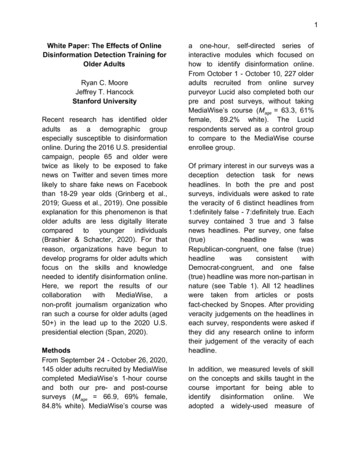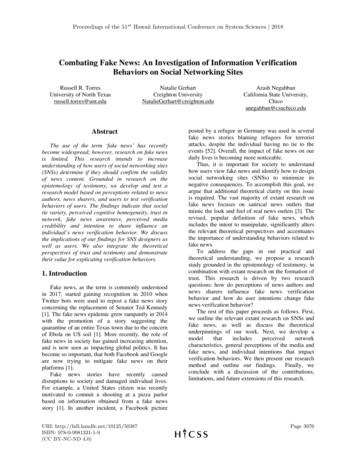
Transcription
Proceedings of the 51st Hawaii International Conference on System Sciences 2018Combating Fake News: An Investigation of Information VerificationBehaviors on Social Networking SitesRussell R. TorresUniversity of North Texasrussell.torres@unt.eduNatalie GerhartCreighton UniversityNatalieGerhart@creighton.eduAbstractThe use of the term ‘fake news’ has recentlybecome widespread; however, research on fake newsis limited. This research intends to increaseunderstanding of how users of social networking sites(SNSs) determine if they should confirm the validityof news content. Grounded in research on theepistemology of testimony, we develop and test aresearch model based on perceptions related to newsauthors, news sharers, and users to test verificationbehaviors of users. The findings indicate that socialtie variety, perceived cognitive homogeneity, trust innetwork, fake news awareness, perceived mediacredibility and intention to share influence anindividual’s news verification behavior. We discussthe implications of our findings for SNS designers aswell as users. We also integrate the theoreticalperspectives of trust and testimony and demonstratetheir value for explicating verification behaviors.1. IntroductionFake news, as the term is commonly understoodin 2017, started gaining recognition in 2010 whenTwitter bots were used to repost a fake news storyconcerning the replacement of Senator Ted Kennedy[1]. The fake news epidemic grew rampantly in 2014with the promotion of a story suggesting thequarantine of an entire Texas town due to the concernof Ebola on US soil [1]. More recently, the role offake news in society has gained increasing attention,and is now seen as impacting global politics. It hasbecome so important, that both Facebook and Googleare now trying to mitigate fake news on theirplatforms [1].Fake news stories have recently causeddisruptions to society and damaged individual lives.For example, a United States citizen was recentlymotivated to commit a shooting at a pizza parlorbased on information obtained from a fake newsstory [1]. In another incident, a Facebook pictureURI: http://hdl.handle.net/10125/50387ISBN: 978-0-9981331-1-9(CC BY-NC-ND 4.0)Arash NegahbanCalifornia State University,Chicoanegahban@csuchico.eduposted by a refugee in Germany was used in severalfake news stories blaming refugees for terroristattacks, despite the individual having no tie to theevents [52]. Overall, the impact of fake news on ourdaily lives is becoming more noticeable.Thus, it is important for society to understandhow users view fake news and identify how to designsocial networking sites (SNSs) to minimize itsnegative consequences. To accomplish this goal, weargue that additional theoretical clarity on this issueis required. The vast majority of extant research onfake news focuses on satirical news outlets thatmimic the look and feel of real news outlets [3]. Therevised, popular definition of fake news, whichincludes the intent to manipulate, significantly altersthe relevant theoretical perspectives and accentuatesthe importance of understanding behaviors related tofake news.To address the gaps in our practical andtheoretical understanding, we propose a researchstudy grounded in the epistemology of testimony, incombination with extant research on the formation oftrust. This research is driven by two researchquestions: how do perceptions of news authors andnews sharers influence fake news verificationbehavior and how do user intentions change fakenews verification behavior?The rest of this paper proceeds as follows. First,we outline the relevant extant research on SNSs andfake news, as well as discuss the theoreticalunderpinnings of our work. Next, we develop amodelthatincludesperceivednetworkcharacteristics, general perceptions of the media andfake news, and individual intentions that impactverification behaviors. We then present our researchmethod and outline our findings.Finally, weconclude with a discussion of the contributions,limitations, and future extensions of this research.Page 3976
2. Literature Review and TheoreticalUnderpinnings2.1. Social Network SitesThe research on SNSs, such as Facebook,LinkedIn, and Twitter, is vast and investigatesvarious impacts of SNSs on both individuals andorganizations. At the organizational level, SNSsprovide a platform to establish connections withcustomers, identify customer needs, and receivefeedback [28, 36, 47].For individuals, SNSs provide a platform wherepeople can share information, exchange ideas aboutvarious topics, arrange civic and political activities,participate in social events, and disseminate news.Researchers have studied various characteristics ofSNSs and their impacts, including strength of socialties [27], SNS addiction [50, 57], and the role ofSNSs in news dissemination and civic and politicalparticipation [2, 37].Today, SNSs have become a news source formillions of people [30], and are commonly used toraise public awareness about elections [60]. Newsorganizations now actively employ SNSs to expandtheir reach [45], and research indicates that SNSsallow a more rapid spread of news through individualsharing of stories [10]. As a result, every individualcan become a news source, which raises concernsabout the validity of news sources and the spread offake news. To date, there is relatively little researchthat investigates how SNS users verify the accuracyof information received through their network [64].2.2. Fake NewsTraditionally, research defined fake news as atelevision comedy genre in which a portion of theprogram is devoted to political satire [29]. Suchprograms draw millions of viewers by mimicking atraditional news cast, but adding humor [18, 30].While critics argue that these programs confuse factwith humor, some researchers argue that they may beas informative as network news broadcasts, and mayeven attract an audience that is not interested intraditional news programs [18, 30].However, the popular definition of fake news hasrecently undergone a transformation. The term fakenews is now commonly applied to phony newsstories maliciously spread by outlets that mimiclegitimate news sources. There are three definitionsof information necessary for understanding fakenews: information, which is communication in asocial context; misinformation, which is falseinformation; and disinformation, which isinformation that is deliberately false [32]. Fake news,as it is now understood, is defined as false andmisleading information [2], and therefore includesboth misinformation and disinformation.Fake news presents a challenge to society becauseexposure can affect the audience’s perceptions [3,30]. Fake news can affect trust [4, 56], shapepeople’s perceptions of others [38, 46], and influenceopinions of serious news and political debates [35].People exposed primarily to fake news may perceiveit as more realistic than legitimate news [3]. Researchalso shows that even if readers are told information isnot true, a distinct cognitive process governs whetherthey choose to believe it [21].Mitigating the impact of fake news is hamperedby the fact that it is difficult to distinguish fromlegitimate news. Fake news that appears to originatefrom a traditional news source has a greaterlikelihood of impacting the observer [7]. This issueis compounded because both fake and legitimatenews stories are shared through SNSs, furthercomplicating the task of differentiating between thetwo [55]. Even millennials, who spend considerablymore time online than other groups, are oftenincapable of determining the validity of onlinecontent [63].SNSs not only speed up the dissemination of validinformation, but may also be employed todisseminate false information with great efficiency.As a result, establishing a sound verification processfor news and information is indispensable.2.3. The Epistemology of TestimonyThe concept of truth has been examinedextensively in the fields of philosophy, psychology,and information systems. Due to the volume andcomplexity of extant theorizing on this notion, weoffer a brief, and necessarily superficial, discussionof the relevant aspects of this concept.Truth is, at least in part, the domain ofepistemology, a branch of philosophy that examinesknowledge and its acquisition. Of particularrelevance is literature about the epistemology oftestimony. This theory of knowledge is concernedwith discerning the validity of information acquiredthrough others [41]. Given our reliance on externalsources of information, testimony is critical to the“formation of much that we normally regard asreasonable belief” [9:7].In accordance with Shieber [51], weconceptualize testimony in the SNS context as theconveyance of information through written oraudio/visual communication. Thus, testimony is thePage 3977
act of disclosing information, while the epistemologyof testimony is concerned with how recipients assessthe veracity of that disclosure. For example, if anSNS member shares a news article or video, thatmember has engaged in an act of testimony. If arecipient of that article makes a judgement about itstruth, that person has made an epistemic evaluation ofthe testimony. While we commonly think of“testimony” in the context of formal legalproceedings, communication among members of asocial network can be viewed as one of many “socialoperations of the mind,” and thus is a form of natural,rather than formal, testimony [13:38]. Such naturalconveyances of information are pervasive in oureveryday lives and are highly influential in theformation of our beliefs [51].A fundamental precept of the epistemology oftestimony is that the transmission of informationthrough others dramatically alters the way in whichinformation is converted into knowledge [41].Rather than being able to directly assess the veracityof first hand empirical evidence, the recipient oftestimony makes subjective judgements regarding thetruth of information conveyed by the testifier. Theseassessments are necessary as the testifier may haveunderlying motives which influence the transmittedinformation and its conversion into knowledge [51].Thus recipients strive for “appropriate, but notprofligate, trust in the testimony of others” [51].Based on the epistemology of testimony, Fallis[13] identifies four considerations when assessing theveracity of recorded information: authority,independent corroboration, plausibility and support,and presentation.Table 1 summarizes theseconsiderations and indicates those most central to thepresent paper.Table 1. Establishing the Truth of ationPlausibilitySupportPresentationandAddresses The characteristics of thetestifier (who testifies)The presence of otherswhooffersimilartestimony (how manytestify)Thenatureoftheinformation and logicoffered in its support (whatthey testify)The characteristics ofvehicle through whichtestimony is offered (howthey testify)IncludedYesYesNoNoWhile each of these considerations is likely to beinvolved in establishing the truth of informationshared through SNSs, this research is primarilyconcerned with characteristics and behaviors ofnetwork members. As such, we focus on authorityand independent corroboration, as they are bothdirectly related to the characteristics of SNS membersand their behaviors.Authority is related to the characteristics of theindividuals from whom the information is obtained[13]. Research suggests that authority may beinterpreted as a signal of trustworthiness [51] and thatinformation obtained from a trusted source is, itself,often trusted [13]. Assessing the authority of atestifier may take many forms. Historical accuracy isof significant importance when evaluating authority[13]. That is, has the information conveyed by aparticular source been accurate in the past. Suchconsistency is a hallmark of trust. Credentials whichsignify specialized knowledge, another means ofestablishing authority, also commonly engender truston the part of a testimony recipient [43]. Finally,interlocutors that are perceived as being free of bias,may be perceived as authorities and establishthemselves as trustworthy testifiers [13].Thatauthority engenders trust is important in this contextas trust serves as a form of justification for thetestimony, allowing it to be accepted andincorporated as knowledge [39]. In the present study,authority may be assessed for two groups: newssharers (individuals within the network who sharenews) and news authors (the organizationsresponsible for creating news articles).Independent corroboration represents an attemptby an individual to obtain alternate and unrelatedsources of information to validate testimony [13].Agreement by multiple sources is often considered astrong indicator of accuracy and is similar to theacademic notion of triangulation [61]. Ideally, suchcorroborating evidence should be sought fromsources that obtained the information independentlyin order to minimize the possibility that all sourcesare distributing inaccurate information derived fromthe same origin [13]. Fallis notes that this asignificant issue in the context of the Internet giventhe ease with which the same information may bedistributed via multiple websites [13]. In this study,news verification behavior is a measure ofindependent corroboration as it represents an attempton the part of the news recipient to validateinformation using alternate sources.Importantly, literature on the epistemology oftestimony suggests that authority and independentcorroboration are not independent [13]. Rather, theassessment of truth derived from a given techniqueinfluences the nature of assessments using othertechniques. In other words, when faced with anunsatisfactory assessment, recipients commonly fallback to other means of evaluation. This notion, thatPage 3978
subjects form beliefs based on their directassessments of the information source and onadditional informational assessments, is a centraltenet of most contemporary research on testimony[51]. For instance, if a recipient is unable to assessthe authority of a testifier, or if the results of thatassessment suggest fallacy, the recipient may seekothers who offer similar testimony in order todevelop more complete assessment of the credibilityof the information. This phenomenon provides thefoundation of our theoretical underpinnings.3. Model DevelopmentDrawing upon extant literature on the nature ofinformation, the epistemology of testimony, andinterpersonal trust, we develop a model (Figure 1)that examines factors that influence verificationbehaviors among recipients of news shared withinsocial networks.Figure 1. A model of news verification behavior3.1. Perceptions of News SharersResearch suggests that judgements regarding theveracity of information exchanged on SNSs depend,in large part, on the individuals from whom theinformation is received [64]. As such, thecomposition of the network is likely to play asignificant role in the news verification behaviors ofnetwork members. In the present study, we assessSNS composition, i.e., the perceived characteristicsof news sharers, using three constructs: social tievariety, perceived cognitive homogeneity, and trustin network.Social tie variety is defined as “the diversity ofoffline groups and contexts represented in one’sonline social network” [20]. An individual’s networkmay be composed of people introduced to that personover a long period of time and in a wide variety ofsocial contexts. At the core, social tie variety is abouthow people met, and if they met through severaldifferent life periods, there is an increased likelihoodfor diversity. As that variety increases, the diversityof backgrounds represented in the network increases[12], which also means a higher likelihood ofexposure to fake news. The focal user may becomeaware that news offerings are fake when members oftheir network share news items that present factsabout a given topic that are diametrically opposed toone another. Such disagreement illustrates a lack of“general acceptability” and serves as a cue todeception [34]. Thus, even if an individual does notclearly identify which news item is true and which isfalse, the presence of conflicting viewpoints indicatesthat at least one news item is likely untrue, therebyincreasing the individual’s awareness of fake news.Thus, over time, continued exposure to a diverse setof perspectives and opinions on a SNS increasesone’s fake news awareness. Therefore, we posit:H1a: Social tie variety is positively related to fakenews awareness.As an individual’s social tie variety increases,the person becomes exposed to a larger variety ofideas put forth by a more diverse network. Thus,social tie variety may be viewed as a measure of thecorrespondence between the social characteristics ofthe members of the SNS community. However,research suggests the development of interpersonaltrust is hampered in situations where social similaritybetween the trustor and prospective trustee is lacking[31]. Trust is an integral, albeit complex, elementwhich governs interactions within SNSs [23].Consistent with the view that interpersonal trustconsists of trusting beliefs and trusting intentions [42,43], we define trust in SNS as the trusting beliefsheld by an individual regarding the other members oftheir network. Dissimilarity between individualsnegatively influences assessments of entitativity, theextent to which the parties perceive that they are partof a single group [8], and is associated with lowerlevels of trust [53]. Research suggests therelationship between collaboration as a member of aperceived group and increased levels of trust isdeeply rooted in our neurobiology [14], and thisrelationship is well-supported in the extant literaturefrom a wide variety of academic disciplines [33].Thus, we posit:H1b: Social tie variety is negatively related to trustin network.Even in networks characterized by high levels ofsocial tie variety (varied backgrounds of networkmembers), there exists a possibility that the membersof the group have strong, commonly-held beliefs.Perceived cognitive homogeneity is, “the extent toPage 3979
which a person perceives members of his/her SNSnetwork to share his or her views and beliefs” [20].Instead of how people know each other (their socialties), this is a user’s perception of the diversity ofbeliefs in their network. For example, a social tie tosomeone might be that they are a family member,however the perceived cognitive homogeneity mightbe very low. As a result, these are distinct measuresof perceived diversity within a network. There isconsiderable evidence that some individuals constructsocial networks that exclude viewpoints with whichthey do not agree [2]. This behavior is related tohomophily, our desire to engage with those that thatwe perceive as similar, a phenomenon widely studiedin the SNS context [44]. However, because theunderlying beliefs of SNS members are reflected inwhat they post [11], network segments characterizedby a large degree of cognitive homogeneity reflectless topic diversity than segments which are moreheterogeneous in nature [20]. In such contexts,individuals are less frequently exposed to alternativeviewpoints and counterarguments related to theirbeliefs. Combined with confirmation bias, this islikely to decrease opportunities to identify falseinformation and lower awareness of fake news. Thus,we hypothesize:H2a: Perceived cognitive homogeneity is negativelyrelated to fake news awareness.As described previously, trust is highly related toperceptions of similarity between the trustor andtrustee. While similarity may be judged on the basisof characteristics such as social background or evenappearance [33], similarity of beliefs is particularlyimportant. This is because unlike the more superficialapproaches to discerning similarity, the identificationof common belief structures requires knowledgebased familiarity, a particularly strong antecedent oftrust [19]. Because SNSs are used to project adesired social identity that exemplifies the beliefs ofthe individual [14], posts serve as cues which allownetwork members to evaluate the degree of cognitivehomogeneity that exists between themselves andother network members [20]. Individuals thatperceive themselves as having similar opinions andthoughts as other network members are likely toconnect more deeply than individuals that perceivethemselves as different [48]. In the absence ofcognitive homogeneity, the development ofinterpersonal trust between the focal user and othernetwork members is expected to be inhibited. Thus,we offer the following hypothesis:H2b: Perceived cognitive homogeneity is positivelyrelated to trust in network.There is considerable empirical support for thecontention that beliefs influence the actions taken byIS users in online environments. On SNSs, trust hasbeen found to be an important governancemechanism which regulates the behavior of networkmembers [23, 37]. Importantly, trust often serves asa mental shortcut, allowing interaction in complexsituations without overwhelming the cognitivecapacity of the trustor [24, 43]. In particular, in thepresence of trust, an actor may forgo behaviors inwhich they might otherwise engage. For instance,McKnight and Chervany identify the relaxation ofcontrols as a common trust-related behavior [42].Hence, we posit that in the presence of a high level oftrust, a news recipient may forgo validation, choosinginstead to rely on those they find credible to assessvalidity. Thus, we offer the following hypothesis:H3: Trust in network is negatively related to newsverification behavior.3.2 Perceptions of News AuthorsAs previously mentioned, in the context of newsdistributed through SNSs, the focal user may formimpressions regarding news authors in addition toimpressions about network sharers. Beliefs aboutnews authors are also likely to influence verificationbehaviors. In this study, we assess these perceptionsusing the previously discussed construct, fake newsawareness, as well as media credibility.Credibility is crucial for any information sourceas its audience is generally highly interested inaccuracy [13]. Consumers have numerous options fornews coverage and the credibility of a given outletmay influence preferred source selection [5]. Mediacredibility is related to perceptions of believability,accuracy, trustworthiness, bias, and completeness[15], and is thus highly related to trusting beliefsidentified in prior research such as competence,benevolence, and integrity [42]. As individualsbecome aware that news items from a particularsource are likely false, at best they may perceive thatsource as incompetent. At worst, they may begin toquestion the benevolence and integrity of that source.Thus, in the words of Gunther, media credibility is“an audience response to media content” [26:147].As such, we argue that individuals with higher levelsof fake news awareness tend to be more skepticalabout the credibility of the media, and thushypothesize that:Page 3980
H4: Fake news awareness is negatively related tomedia credibility.H6: Intention to share is positively related to newsverification behavior.Research shows that online users assess thecredibility of web-based information, but bothcredibility assessments and verification behaviorsvary by the type of information sought [15, 16].News is generally perceived to be more credible thanother types of online content [16]. It is clear,however, that news consumers recognize a widevariety of credibility issues with news sourcesranging from incompetence to bias and deceptivepractices [2]. Upon discovery of credibility issues,individuals commonly seek alternative sources inorder to validate the accuracy of the informationbeing conveyed [5, 13]. Thus the influx of fake newson SNSs not only heightens skepticism of newssources, but is also likely to encourage networkmembers to be more vigilant in their efforts to assessthe veracity of the news they consume via the SNS.As such, we offer the following hypothesis:4. MethodologyH5: Perceived media credibility is negatively relatedto news verification behavior.3.3 User IntentionsFinally, in addition to assessments about both theoriginal source of news content as well as about themembers of the SNS through which that newspropagated, a user’s intentions related to the newsitem may also play a role in their verificationbehavior. SNS users often engage in identitymanagement by carefully crafting a persona throughtheir posts [62]. While posts are critical in theconstruction of the public identity, they may also teardown the public identity if they are construed asnegative or misleading [59]. Thus, the curation ofone’s social identity may require significant effort toensure that each post, whether original or shared,presents the desired public image [20]. However,users with no intention to share (commonly referredto as lurkers in internet parlance), do not engage insuch identity management efforts as they do not post[22]. In the context of the present study, if anindividual receives a news item but has no intentionof sharing that post, they are less likely to activelyverify that news item in order to protect their onlinepersona. The converse is also true. Because thedissemination of fake news can significantly harmone’s credibility within their network, those with agreater intention to share are more likely to engage ininformation verification behaviors. Thus, we posit:To test our research model, we developed asurvey composed of previously validated measuresthat were contextualized to the fake news context.News verification behavior was adopted from theinformation verification behavior construct inFlanagin and Metzger [15]. Media credibility wasalso adopted from Flanagin and Metzger [15]. Socialtie variety and perceived cognitive homogeneity wereadopted from Gerhart and Sidorova [20]. Fake newsawareness was adopted from the security context [6]and several additional items were developed.Intention to share was adopted from Lee and Ma[37]. Finally, trust in network was adapted fromVerhagen, Meents, and Tan [58].The survey was conducted with students in theUnited States from three different universities. Theuniversities varied by region, size, and demographics,which helps increase generalizability. The studentpopulation is composed of primarily millennials, whoare an appropriate sample because they use SNSsmore than any other age group [25].Table 2: DemographicsAge19-2425-2930-3435 .4%GenderMaleFemaleOtherNetwork 4991500 Table 2 contains complete demographics. A totalof 541 people participated in the survey. Aftercleaning the data to remove all incomplete responses,514 usable responses remained. As expected, 95.9%of participants were aged 19-29 and the majority ofparticipants were male (61.7%). Network size variedgreatly, ranging from zero to several thousandconnections, with most reporting less than 600 intheir network.Page 3981
well under the threshold of 50%. Therefore, commonmethod bias is likely not a concern in this study.5. ResultsTo test the complete model, we employedSmartPLS 2.0. A three-step analysis was completedto assess the measurement model, common methodbias, and the structural model.5.1 Measurement Model AssessmentTo assess the measurement model, bothreliability and validity need to be confirmed.Reliability is determined by a Cronbach’s alpha scorewhich should be greater than 0.70 [48]. All of theconstructs have a Cronbach’s alpha value of 0.76 orgreater, indicating acceptable reliability. Convergentvalidity is determined by AVE values of 0.5 orgreater [17]. The minimum AVE score is 0.52indicating acceptable convergent validity. Todetermine discriminant validity, the square-root ofAVE should be greater on the designated constructthan other constructs [17]. As indicated in Table 3,all of the cited criteria are met.Table 3: Measurement Model 40.130.82TN0.780.320.040.160.160.350.28TN5.3 Structural Model AssessmentTo assess the structural model, we evaluated thestrength of relationships between variables and thepredictive power of the model. The complete resultsare presented in Figure 2.The structural model reveals support for all ofthe hypotheses presented. The relationship betweenperceived cognitive homogeneity and fake newsawareness (H2a) is significant at the 0.05 level. Therelationship between media credibility and newsverification behavior (H5) is significant at the 0.01level. All of the remaining hypotheses are significantat the 0.001 level. The relationship between social tievariety and trust in network (H1b) is hypothesizednegative, however it is positive. Similarly, therelationship between trust in network and newsverification behavior (H3) was hypothesized asnegative and results in a positive relationship. Theremaining hypotheses exhibit the expected directionof the relationship.Social tie variety and perceived cognitivehomogeneity explain 5.0% of the variance in fakenews awareness and 15.4% of the variance in trust innetwork. Media credibility, trust in network, andintention to share explain 11.9% of the variance innews verification behavior.0.89Construct Abbreviation: Construct Name (Cronbach Alpha)Cog: Perceived Cognitive Homogeneity (0.91), FNA: Fake NewsAwareness (0.92), Ver: News Verification Behavior (0.90), Int: Intention toShare (0.88), MC: Media Credibility (0.89), STV: Social Tie Variety(0.76), TN: Trust in Network (0.91)Note. The diagonal elements are the square roots of the AVE.5.2 Common Method BiasCommon method bias is an issue that candevelop as an inadvertent result of research methodand is a concern in survey research [49]. To test forcommon method bias, we conducted Harman’s
California State University, Chico . anegahban@csuchico.edu. Abstract. The use of the term 'fake news' has recently become widespread; however, research on fake news is limited. This research intends to increase understanding of how users of social networking sites (SNSs) determine if they should confirm the validity of news content.
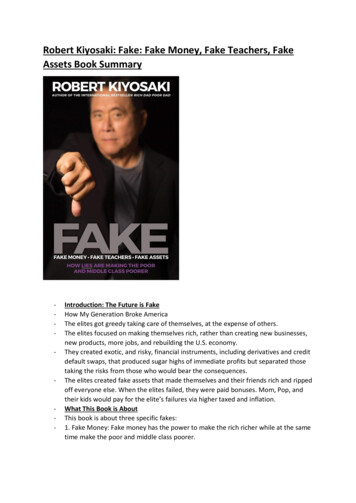


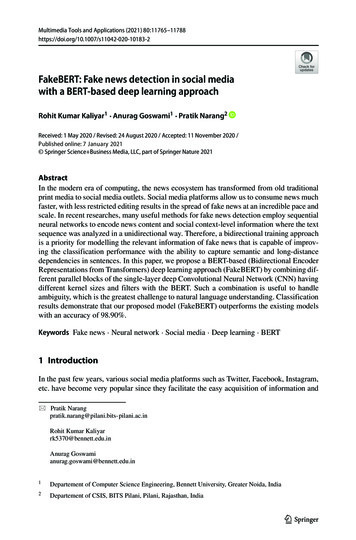
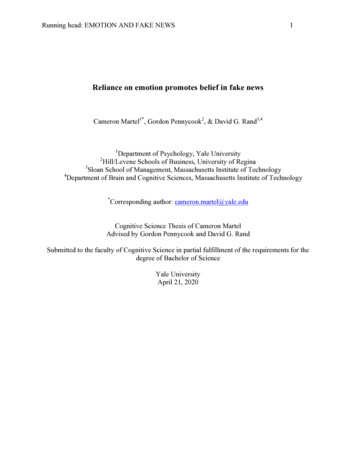
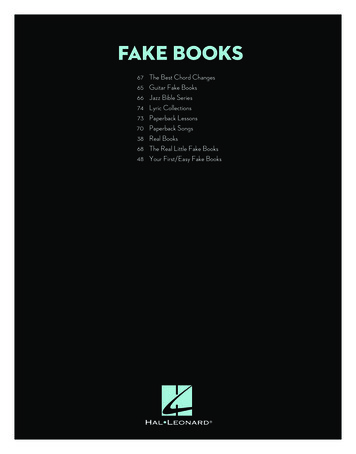
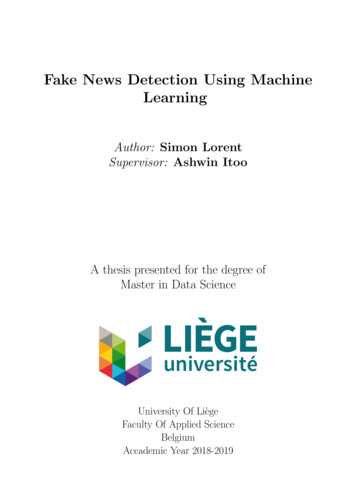
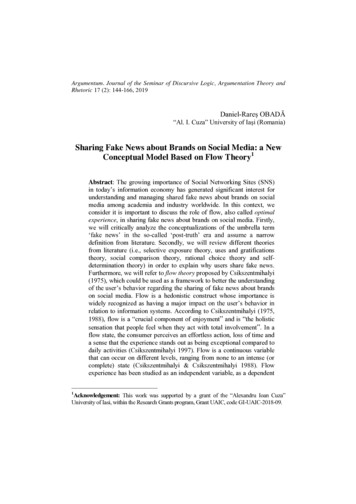
![Fake Notepad Crack Free X64 [Latest 2022]](/img/41/fake-notepad-crack-free-download-x64-latest-2022.jpg)

